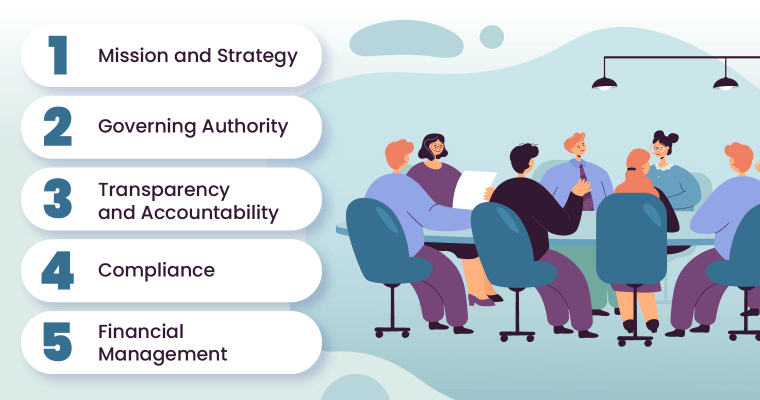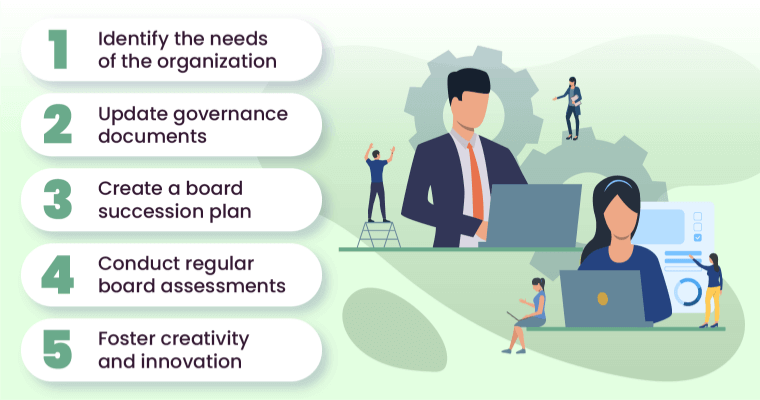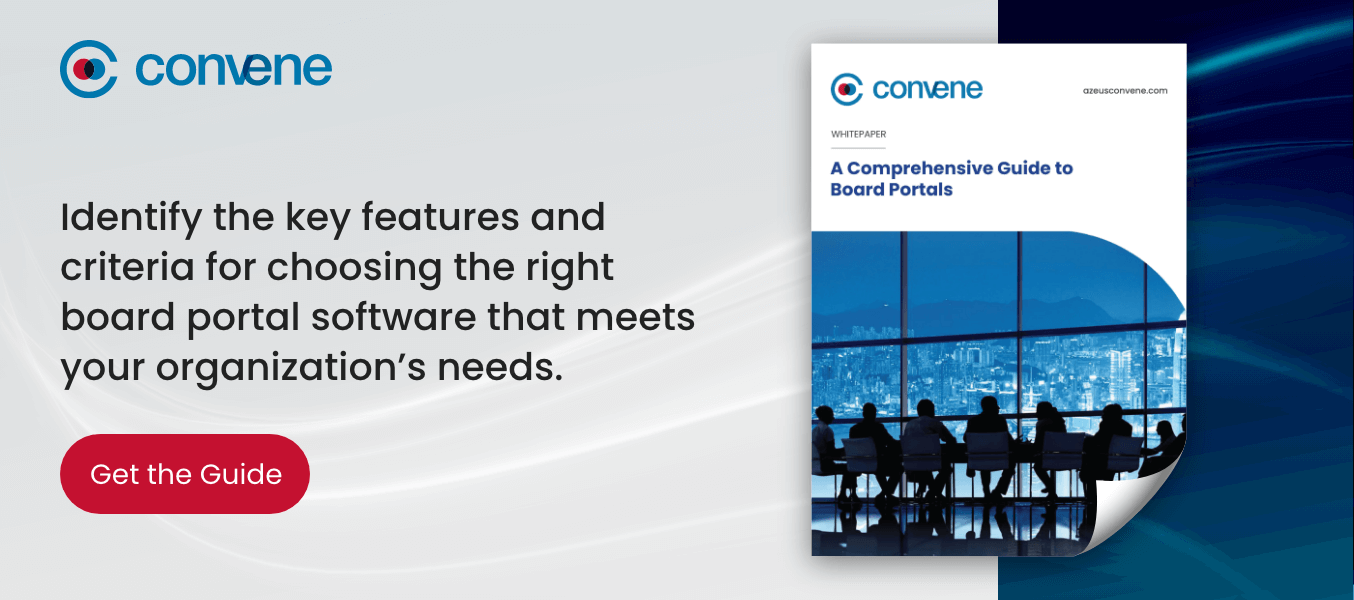Trust and social approval are among the primary impacts of having good governance in nonprofits. To achieve it, nonprofit leaders must recognize the shifting trends in governance and the amplified demands of the public to be accountable, transparent, and inclusive. Understand how strategic leadership transforms nonprofit governance in this article.
What is nonprofit governance?
Nonprofit governance is the framework that nonprofits use in managing their operations, compliance, and finances. Such a type of governance is necessary for keeping nonprofit organizations accountable to their stakeholders. A nonprofit with effective and strong leadership exhibits good decision-making and transparency. These qualities help them gain credibility and trust from their supporters and the general public.
The highest governing body of nonprofits are board of directors, and below them are executives and committees. Here is how these key groups collaborate in governing nonprofits to ensure long-term success:
Governance Structure in Nonprofits
Board of Directors
The board of directors is instrumental in strategy development. They are the primary governing body in nonprofits that champions accountability and transparency. This unit is responsible for overseeing operations and regulating compliance across departments. The nonprofit board is a group of strategic and visionary leaders that deliberate on high-level matters and make consensus decisions which they communicate through resolutions.
Executive Director
This position is equivalent to a CEO in some organizations. The role is given to a board member who is tasked with executing the direction set by the board. To do this, the executive director handles the day-to-day operations of the entire organization; making sure that teams are meeting targets. To keep the board updated with operational issues, the executive director delivers reports on issues raised by departments or committees.
Committees
These groups are formed by the board of directors. As nonprofits grow in size, they require more delegation and oversight in the presence of committees. Committees carry out responsibilities in support of the board and the executive director based on their specific assignments or departments. These committees are rare in for-profit organizations, and their numbers differ by organization. Some of the most common committees in nonprofits are the fundraising committee, executive committee, marketing committee, public relations committee, and membership committee.
What is the importance of strong governance in nonprofits?
The public has become more direct in their expectations which demands more responsive nonprofit leadership. The presence of strong and competent governance is the cornerstone for nonprofits. This is because they rely on good reputation and trust to gain support from the general public.
Here are ways strong governance impacts nonprofit organizations:
Development of sound plans and strategies
Good governance is responsive to the concerns of its subjects and the rising challenges in society. This kind of governance is highly cognizant of the needs and expectations of its beneficiaries. They value this insight and weigh them while developing new strategies and optimizing old ones. Plans grounded in practical realities and facts are what form informed and sound strategies.
Adaptive to changing legislation
Nonprofits must follow a set of rules and regulations. This can be difficult to manage, especially if the requirements of the law alter over time. A well-governed nonprofit institutes tenacious and effective compliance systems that analyze legislation to clearly define the organization’s legal duties. It is also less likely to get into legal roadblocks, preventing penalties and liabilities.
Increased accountability and transparency
Transparency is essential to succeed in nonprofit governance. It keeps the organization accountable to its stakeholders — from supporters to the community it serves. When a nonprofit is transparent, the public can see how it operates and where its resources are going. Amongst the ways for nonprofits to show transparency is by being honest about funding, programs, and impacts. This helps to build trust with donors, funders, and the community at large.
Key Elements of Nonprofit Governance

What drives the success of the governance of nonprofit organizations? Below are the key elements that nonprofits should prioritize.
1. Mission and Strategy
Nonprofit missions are presented in statements that summarize their unique purpose. Their mission is the foundation of all strategies they intend to implement. Mission statements not only mandate and influence how organizations should operate, but they also have an important bearing on how workers and volunteers perceive their responsibilities.
2. Governing Authority
The board of directors is the main governing authority in nonprofits. They supervise employees and act as stewards in following their large-scale plans and strategic direction. They are integral in the development of the culture and governance within the organization.
3. Transparency and Accountability
Certain organizations are not subject to taxes because governments consider them to be beneficial to the public. To gain tax-exempt status, a nonprofit must prove that they are a charitable organization and must not operate for private interests. With that, nonprofits should carry out their operations and fiduciary duties with transparency and accountability. They are compelled to be truthful in every report they share with the public and in every document they submit to the government.
4. Compliance
It is through compliance with regulations that nonprofits are able to fund their programs. They have to be worthy of the trust and donations; and that their programs are for the interests of their beneficiaries. Nonprofits need a compliance committee to perpetually understand the requirements in different areas of the organization. Failure to comply often merits serious consequences such as reduced funding, lowered donor trust, IRS audit, and revocation of tax-exempt status.
5. Financial Management
A nonprofit needs formidable financial management to deliver the best services to its beneficiaries and resources to its employees for a long period. They have to implement effective financial management practices to develop trust within and outside the organization, as well as prevent fiscal and funding issues. Here are the top best financial management practices that nonprofit implements:
- Gift Acceptance Policy: This prevents employees from receiving donations from sponsors that are unsuitable for programs and are not in line with the mission.
- Expense Reimbursement Policy: During activities, it is sometimes unavoidable for staff or volunteers to use their own money. When this happens, organizations must have a defined reimbursement policy for these types of expenses. Having a reimbursement policy protects parties and ensures that refunds are based on valid documentation.
- Fiscal Policy: This addresses the internal procedures nonprofit organizations use to adhere to generally accepted accounting principles (GAAP). The policy acts as an instruction manual on how organizations should conduct their financial operations and is updated every year. The primary information that it has is the annual budgets, insurance coverage, financial statements, revenue, expenses, and payroll.
Five Challenges of Nonprofit Governance

Before achieving organizational success, nonprofit board governance comes with certain challenges. Here are five tasks nonprofits usually find challenging to optimize for good governance.
1. Risk management
All staff members should take responsibility when it comes to risk management, from volunteers to the executive staff. Most operations in a nonprofit are fiduciary duties of board members. Mitigating risks is one proactive task that all board members should be actively engaged with.
Setting up risk management policies is another effective way to minimize organizational threats. Such policies can be about confidentiality agreements, gift acceptance, executive compensation, whistleblower protections, and document retention and destruction.
Nonprofits find it challenging to manage risks because of the lack of resources, trust among employees and volunteers, and awareness. First, nonprofits run with limited funding compared to for-profits. The board often prioritizes funding operations and programs first, thus a tendency to neglect to allocate funds for risk management initiatives later on.
Second, a lack of trust and openness among staff and volunteers produces weak teams and poor judgment. This can cloud decision-making and may lead the organization to make a series of bad decisions in the long run.
Finally, the lack of situational awareness among executives and staff makes the organization ill-prepared and prone to incidents such as theft, data breaches, fundraising scams, and employment issues.
2. Conflict of interest
Conflict of interest can damage the entire organization if neglected. For instance, the trust built among members, volunteers, and donors may be negatively impacted, even with the simplest conflict of interest. Nepotism is one example that shows conflict of interest. There are instances when leaders give special consideration to family members or friends during the hiring process. They place them in positions with improper processes even if they do not meet the requirements. Another instance is when employees or executives exploit the networks of the organizations for personal gain.
These situations can be prevented with the development of a well-constructed conflict of interest policy to handle agreements and transactions with clarity. Regularly discuss and circulate the policy to all the nonprofit members. From there, the organization can readily see, analyze, and document potential conflicts of interest. The creation of alternative arrangements for disinterested board members can also be considered.
3. Program reviews
First off, the executive must deliver regular reports about how the charities are doing. Since public welfare is the ultimate goal of many nonprofits, overseeing programs is as critical as watching the finances. Nonprofits can sometimes become so focused on raising funding and project execution that they neglect post-project processes such as evaluations, documentation, and reporting.
For this, organizations can start with basic strategic planning or a SWOT analysis. With proper evaluation schemes, nonprofit boards can assess program issues and successes. They can use the analysis to develop an outcome evaluation plan that collects and analyzes data.
4. Task delegation
Many nonprofit boards choose to delegate tasks to staff members and committees, then leave it as is. Delegating responsibility requires effective supervision and monitoring to prevent problems relating to compensation policies, performance expectations, and overall budget.
Governance committees can handle difficult tasks that require more effort and time, such as compensation, audits, investments, and finances. Members with delegated responsibilities should also provide periodic reporting and review expenditures, and other financial statements annually.
5. Diversity
Cultivating diversity is a common challenge in nonprofit governance. For example, board recruitment typically involves considering colleagues or friends to fill the vacancies. The initial board may contact people from the same neighborhoods, schools, professions, and clubs.
If the nonprofit board wants to add valuable perspectives, they can focus on creating diversity. This means bringing in a matrix of backgrounds, experiences, and skills. In addition, a diverse board can help an organization handle blind spots and expand its reach.
Five Nonprofit Governance Best Practices

Running a nonprofit board may differ depending on the organization’s needs and governance model. To give a guide in proactive management, below are some nonprofit board governance best practices.
1. Identify the needs of the organization
Asking board members directly about their needs is the first step to boosting effectiveness. Consider that not everyone is confident or vocal enough to say what they want or need. So, before arranging any governance training and resources for the board members, hear what they have to say first.
Have regular surveys or digital poll questions for the board or staff to answer. These are great ways to know how people feel about certain operations or processes. The same goes for providing training and resources. Know what issues to tackle, then decide what training to offer and if it needs to be periodic or not. Some key issues to consider are director liability and duties, funding, political activities, and ethics.
2. Update governance documents
Processes, policies, and practices in a nonprofit organization change over time. With that, any changes shall then apply to the nonprofit’s governance documents. Most organizations conduct an annual review to check for outdated governance documents. This is not only for keeping records up to date but also ensures that the nonprofit remains in compliance.
Among these key documents are the articles of incorporation, policy manual, bylaws, strategic plan, board member roles and responsibilities, and annual budget. Each of these is crucial for nonprofit board members when making decisions. Make sure to follow the guidelines for record-keeping or recording minutes.
3. Create a board succession plan
Usually, nonprofits think about succession only when a director is close to leaving the board. Being reactive in this can lead to problematic performance assessments, a lack of adequate information, and even failure to fill skill gaps and increase board diversity. Become a proactive board and build a comprehensive succession plan. By doing this, it can smoothen out board turnovers, promote a diverse board, and minimize risks linked to underperforming members.
For proper succession planning, it needs to be institutionalized first. Assign a member to oversee the plan’s creation and overall development. Next, conduct a gap analysis to better understand the desired competencies and determine the organization’s short- and long-term strategies. Lastly, create a pipeline of pre-qualified candidates and update it regularly. This will help the nonprofit board to act quickly during unplanned board vacancies.
4. Conduct regular board assessments
Another important practice is organizing regular board assessments. It should be done annually to help set new priorities for the nonprofit. Start by identifying the potential challenges the organization might face in the coming year. At the same time, remember to address skill levels, weaknesses, and overall performance.
In case they are using questionnaires, be sure to send them a month before the board meeting. It can be questions about board responsibilities, structural patterns, policy-related decisions, strategic actions, or fundraising goals. Discuss also the planned assessments with all the board members, from the initial decisions to the evaluation results.
5. Foster creativity and innovation
Most nonprofits are undeniably focused on supporting their communities. But to catalyze opportunity and growth in the community, an organization must first become strong and well-resourced. One way to do so is by fostering creativity and innovation. Get fresh and unique ideas from members to help with fundraising, donor management, and field programs.
Create an energy field of ideas in the organization to inspire a creative mindset and promote innovation of all kinds. All this can be possible through successful communication with people about why the organization wants to innovate and hear what they have to say. This is not only beneficial for creating new projects or fostering an open and diverse culture but also for becoming a more community-friendly organization.
By understanding the nonprofit’s actual needs and the governance framework, the board can better navigate toward leadership and sustainability. Good governance cannot only improve the performance of nonprofits but also their entire reputation.

Frequently Asked Questions About Nonprofit Governance
How does nonprofit governance impact fundraising efforts?
Fundraising campaigns are often handled by nonprofit boards and executives; spearheading from planning to execution. It means that the quality, frequency, and outcomes of their fundraising initiatives are a strong reflection of their governance. Nonprofits that stick to their mission are more likely to be trusted by donors, resulting in larger donations. On the contrary, donors may become suspicious of nonprofit organizations with poor governance, which may negatively impact their reputation and potential to secure financing.
What are the common nonprofit governance models?
Settling with a nonprofit governance structure makes it easier for leaders to develop their mission, strategic direction, and goals. Having it also gives the board, employees, and volunteers a defined working framework.
Below are the top 5 most common nonprofit board governance models:
- Advisory Model: In this model, the executive director regularly consults with an advisory board to seek pointers on how to run the organization. The governing board can be the same as the advisory board, depending on agreed-upon terms.
- Cooperative Governance Model: This governance model is used by nonprofits that do not have a CEO. There is no hierarchy in cooperative governance and tries to distribute power equally among all nonprofit board members. This type of governance is normally implemented in organizations that are not required by law to have a board of directors.
- Patron Governance Model: Nonprofits that frequently do fundraising campaigns typically use this governance model. Board members who work for this hail from respected and affluent families and provide funding through their connections.
- Policy Board Model: This is the most widely adopted governing model among others. The CEO has the authority to lead the entire organization and make decisions with this governance model. The board of directors regularly evaluates CEOs to uphold their integrity and performance.
- Management Team Model: This governance is put in place to ensure regulatory compliance, just like the cooperative model. It distributes the responsibilities of the board to specific committees. In this model, nonprofits typically often have HR, fundraising, finance, planning, and marketing committees.
What are the consequences of poor nonprofit governance?
Poor governance is the biggest pitfall of nonprofits. Unethical and illegal governance practices will cause supporters to lose faith and confidence. Poor governance will have a negative impact not only on the organization but also on the communities it has committed to supporting.
How can organizations stay updated with evolving nonprofit governance best practices?
The enhancement of nonprofit governance should be added to the workflows of nonprofits. One of the most important best practices for nonprofit boards is to be agile in adopting digital solutions. They must seek innovations that can help their board optimize key governance processes like board meetings, voting, and approvals.
The Future of Nonprofit Board Management Is Digital

Accountability and transparency are important factors in establishing nonprofit governance. Using board management software with a complete suite of collaboration and tracking tools can then make the board members more accountable and engaged with their responsibilities.
Convene has catered to a wide array of leader groups from different industries. It has made its board portal management responsive to the changing challenges of people in workplaces by providing greater security and convenience. Choose a board management software like Convene that can help achieve not just increased collaboration but better governance.
Check out this page to explore Convene’s amazing features and benefits tailored to mission-driven nonprofits.
Jielynne is a Content Marketing Writer at Convene. With over six years of professional writing experience, she has worked with several SEO and digital marketing agencies, both local and international. She strives in crafting clear marketing copies and creative content for various platforms of Convene, such as the website and social media. Jielynne displays a decided lack of knowledge about football and calculus, but proudly aces in literary arts and corporate governance.










